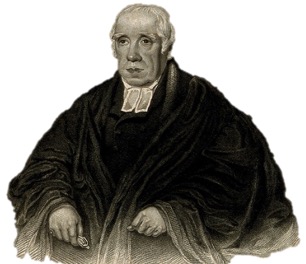
Caterham’s Historical Figures: Reverend John Townsend
By the Junior History Society
Friday 22nd January 2021
Caterham was founded in the year 1811 in a five-bedroom townhouse at West Square in Newington, South London by the Rev. John Townsend, and in 1816, his name appears as a Governor of the school.
Townsend was born on the 24th March 1757, in Whitechapel in London. His father, Benjamin was a pewterer, a metal worker and had a low income. He also had an elder brother, George.
Unfortunately, we do not know much about Townsend’s childhood. We do not even know where he lived as a boy, as the first census was taken in 1801. Normally, it would be wise to check land registry and residence registry records, but it is impossible to pinpoint a specific Townsend family in London at the time, as it was a common name. His early life would have been hard for him and his family.
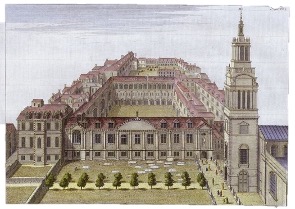
1700 etching of Christ’s Hospital, how the school looked during the time Townsend was a pupil.
The Rev. John Townsend was educated at Christ’s Hospital in 1764. The school was set up in 1552 by Henry VIII and received a royal charter from his heir Edward VI. It had been started due to the number of poor children living dangerously on the streets and after letters from the Lord Mayor, Henry VIII decided to open four hospitals in which children from all backgrounds would be educated and kept safe. The king opened these three special hospitals: Bridwell Palace Hospital (in the remains of Bridwell Palace), at lands in the Savoy (now the King Edward’s School), St Thomas’ Hospital (now an NHS teaching centre) and of course, Christ’s Hospital. Caterham School has even played Christ’s Hospital in many sports in the past.
After five years, in 1771, Townsend finished his studies at the usual age at the time. His wealthy uncle was proud of his achievements and offered to secure places in a college or a post in a Government Office. His father wouldn’t hear any of this and replied, “my child might not resist the ensnaring temptations in this world”. As a result of this, he apprenticed his son to himself. While reluctantly working with his father in his trade as a metal worker, he began to develop a fascination with religion.
John Townsend’s elder brother, George Townsend had followed a religious calling and had become a member of the Countess of Huntingdon’s Connexion, and would eventually become the minister. John eventually persuaded his father to allow him to stop his apprenticeship.
Firstly, he joined and became a member of George Whitefield’s Tabernacle in Moorfields. George Whitefield was a well-known preacher who is said to be one of the founders of Evangelical movements and principles that were gradually becoming popular. Whitefield set up three principal tabernacles in and around London, that remain today. The Tabernacle in Moorfields, where Townsend became a member, has been rebuilt once in 1868. However, it still remains Whitefield’s Tabernacle, Moorfields.
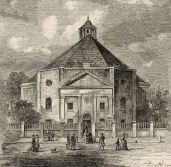
One of the only surviving etchings of the Tabernacle building at Moorfields. Is this how it would have looked when Townsend was a member? Who knows? Maybe one of the gentlemen outside the building may be Townsend himself! Lithograph, 1780.
Townsend met many interesting people at the Tabernacle. He frequently talked and met up with similar people like him, young, and wanting to do something great with their lives. George Whitefield often visited the Tabernacle and grew fond of Townsend. Townsend also attended many of Whitefield’s preachings.
John Townsend then moved and worked at a church at Lewes, then taking charge of the preaching station at Kingston, with an income of around £10,000 today – much more than his father had received per year. It was at Kingston that Townsend met Cordelia Cahusac, the daughter of the minister a nearby church, and the two grew very fond of each other. He was then noticed by clergymen of the nearby Kingston Independent Church, the same Church in which Miss. Cahusac’s father worked, and became the Pastor on the 1st of June, 1781.
Townsend married Miss Cordelia Cahusac the same month, and they registered their marriage in the same church in which Townsend was a Pastor, and Cahusac’s father was the Minister.
Problems arose with the surrounding community over the next couple of years. Hardly anyone appeared for services. The Minster writes:
Kingston is a barren and unpromising soil. Religion is much neglected.
Townsend resigned and was invited as Minister to the Jamaica Row Chapel in Bermondsey within two weeks. The new erection, built in the latest fashion of “neo-classical architecture (the style of buildings inspired by the architecture of the ancient world), with thick stonework and quoins”, had become the heart of the community in that area.
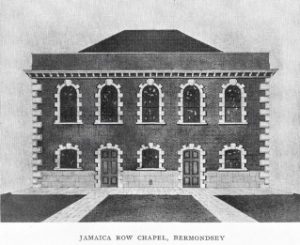
A plate from A History of Caterham School by Hugh Stafford, 1945, Page 11. One of the only surviving, if not the only, drawing of the Jamaica Row Chapel in Bermondsey.
John and Cordelia Townsend made many friends and were welcomed into the social group. Cordelia even started up a finishing school with the help of a few other friends to help the local community with funds and also to bring some extra income into their new family.
Townsend befriended Henry Cox Mason, the Rector at the chapel. Together, in 1792, they both came up with a marvellous idea.
London life for the poor, working class was extremely hard, and Townsend could most definitely relate to this from his childhood, he had often not had enough money to have a meal each day. The Jamaica Row Chapel had helped the poor in the past, with food and shelter. They had also began working on projects for people who were disabled and raised funds to support them in any way possible.
Townsend and Mason had held services and educational sessions for children who were deaf and blind. They began to understand that these children, along with the many, many more, sleeping on the streets or slums in London deserved a proper education designed for their needs.
Townsend and Mason then set up the Committee for The Deaf and Dumb Institution, and in June, 1792, they collected the first subscription; four guineas. This began months of fundraising and collections. It became an absolute success, and they raised much more than they had ever dreamed of. Originally, a townhouse at Bermondsey was taken, but eventually, they had enough money to erect a purpose-built building, designed by Thomas Swithin. In 1807, (the same year the bill was passed to abolish the slave trade by Wilberforce), the foundation stone was laid by the Duke of Gloucester, The Prince William Frederick.
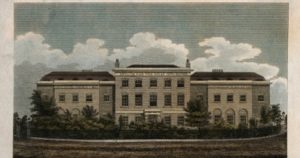
An illustration of the School for The Deaf and Dumb, set up by Townsend and Mason in 1792, and opened in 1807.
The institution stayed in the original building until 1860, when the school decided to design an imposing Victorian style red-brick building in Margate, to help tackle the steep, rising numbers of applicants and to benefit from the proven qualities of fresh seaside air. In 1876, the new school had been built and was open and the school was relocated and eventually renamed The Royal School for Deaf Children. It was closed in 2015.
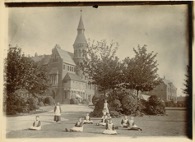
A photograph presenting students during breaktime at The Royal School for Deaf Children, the institution that began as The School for The Deaf and Dumb, which was founded by Townsend and Mason in 1792.
Townsend and Mason visited the institution daily, and many more donations came in, as the school became extremely popular. But in 1810, The Rev. John Townsend set up another Committee, and not for the School for The Deaf and Dumb. It was the Committee for The Congregational School. The School that would become Caterham.
The following events are written about in A History of Caterham School by Hugh Stafford, 1945, P.12.
For long, the thought of the poverty and privations suffered by many Congregational ministers had been a pain and anxiety to him, and he now resolved to do something about their condition : the education of their children.
Townsend had obviously understood the hardships that many children were going through from his own childhood, and when he heard that his fellow Congregational Ministers and their families in London were suffering, he wanted to do something about it. The Jamaica Row Chapel helped out the families with food and shelter and raised funds. But, overall, he wanted to ensure that their children were getting the education they could no longer pay for but needed.
The children tried attending a local church school, but after several weeks, the parents of other pupils wrote to suggest them expelled as they were “dissenters”. The children were also excluded from any form of public education as they were “dissenters”, due to their families’ religious background – a horrific manifestation of the harsh society view on religious beliefs that caused immediate exclusion from many forms of education at the start of the 1800s.
But, Townsend would not take this. He would not see these poor children, from families who had done nothing wrong to deserve immediate exclusion simply because they believed in congregational principles.
The Committee was formed, and they met on 22nd April 1811, at the King’s Head Tavern. Mr Bunnell took the chair, and they decided to call the institution The Congregational School.
Donations were taken and received, and a residential house was rented on West Square in Newington (the origin for the schoolhouse name today), in the year 1811. No. 29 West Square had five bedrooms and three reception rooms. It had six pupils that had enrolled to begin with, the first being S.A Davies.
The Committee decided that the institution should be relocated, and many sites were considered, and one was selected in Lewisham in 1816. It was a country house, as Lewisham was just at the outskirts of London in 1816. This too, is where the name for the schoolhouse Lewisham derives from. The property is described as:
…consisted of over two acres of land, with a house (nearly new, and capable of accommodating some fifty boys), a stable, hay-loft, chaise-house, wash-house, laundry and dairy.
The school would being to grow, thrive, and flourish, giving education to children who were excluded from the other schools due to their family’s religious befliefs and thoughts.
The Rev. John Townsend was an extraordinary person. He was a Minister, an author, a philanthropist, a man of charity and an educator. The principles that he practised remain at the heart of the Caterham School to this day. To help those around you, to be brave, to be resilient, and to always believe.
Veritas Sine Timore.
Truth Without Fear.
Written by Narayan Minhas Ray, Second Year, on behalf of the Junior History Society
The Junior History Society have been involved in projects in discovering the school’s history and traditions.
You can find more of their work at CaterhamHistory on Instagram and at catshistory on Twitter.
#ThenAndNow #CaterhamConnected
ACKNOWLEDGEMENTS
Mrs. Hebden, Alumni Officer – for her time, effort, and support in helping the Junior History Society produce and publish their work.
Mr. Bagnall, Archivist – for his invaluable information, knowledge on the school’s history and time and effort in maintaining the school’s archive.
Miss Jones, Teacher of History – for her constant support, understanding and tireless work in making History come alive.
FURTHER READING
A History of Caterham School by Hugh Stafford (1945)
Independent Spirit by Nigel Watson (2011)